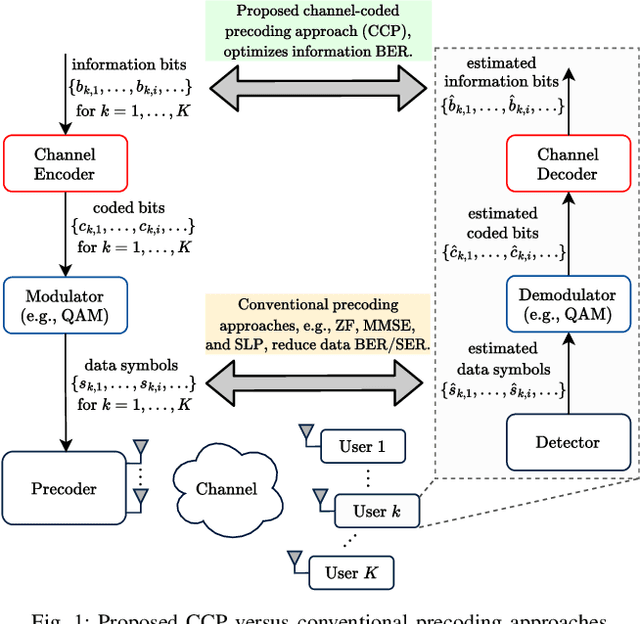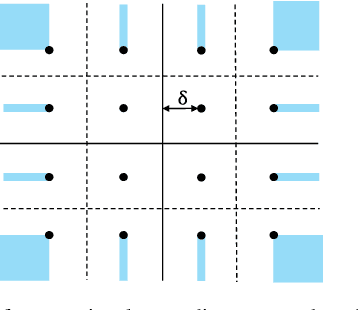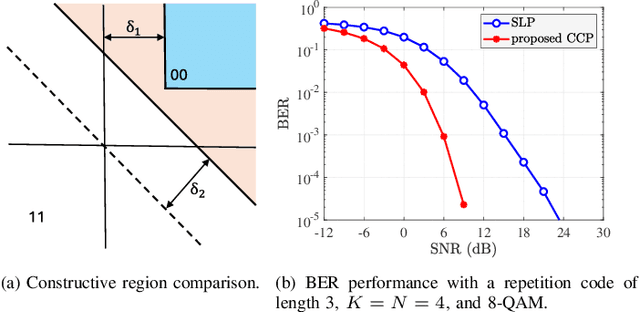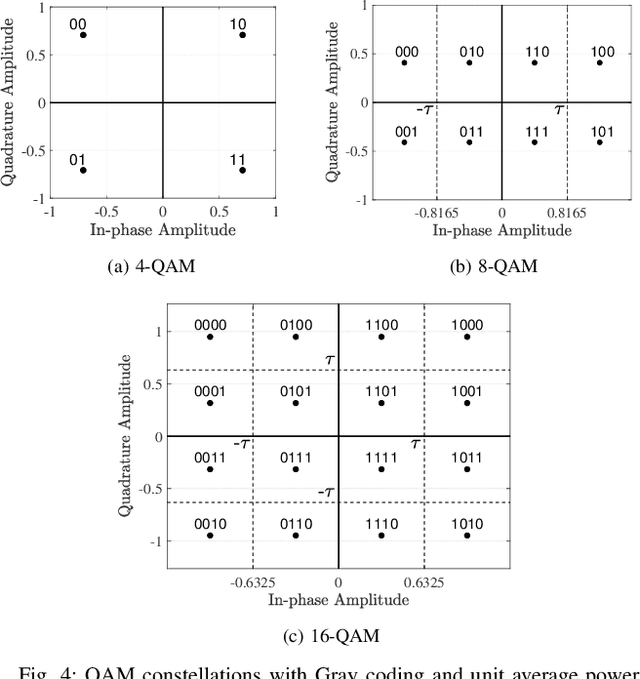Ly V. Nguyen
Exploiting Symmetric Non-Convexity for Multi-Objective Symbol-Level DFRC Signal Design
Apr 19, 2025Abstract:Symbol-level precoding (SLP) is a promising solution for addressing the inherent interference problem in dual-functional radar-communication (DFRC) signal designs. This paper considers an SLP-DFRC signal design problem which optimizes the radar performance under communication performance constraints. We show that a common phase modulation applied to the transmit signals from an antenna array does not affect the performance of different radar sensing metrics, including beampattern similarity, signal-to-interference-plus-noise ratio (SINR), and Cram\'er-Rao lower bound (CRLB). We refer to this as symmetric-rotation invariance, upon which we develop low-complexity yet efficient DFRC signal design algorithms. More specifically, we propose a symmetric non-convexity (SNC)-based DFRC algorithm that relies on the non-convexity of the radar sensing metrics to identify a set of radar-only solutions. Based on these solutions, we further exploit the symmetry property of the radar sensing metrics to efficiently design the DFRC signal. We show that the proposed SNC-based algorithm is versatile in the sense that it can be applied to the DFRC signal optimization of all three sensing metrics mentioned above (beampattern, SINR, and CRLB). In addition, since the radar sensing metrics are independent of the communication channel and data symbols, the set of radar-only solutions can be constructed offline, thereby reducing the computational complexity. We also develop an accelerated SNC-based algorithm that further reduces the complexity. Finally, we numerically demonstrate the superiority of the proposed algorithms compared to existing methods in terms of sensing and communication performance as well as computational requirements.
Deep Unfolding-Empowered MmWave Massive MIMO Joint Communications and Sensing
Nov 25, 2024



Abstract:In this paper, we propose a low-complexity and fast hybrid beamforming design for joint communications and sensing (JCAS) based on deep unfolding. We first derive closed-form expressions for the gradients of the communications sum rate and sensing beampattern error with respect to the analog and digital precoders. Building on this, we develop a deep neural network as an unfolded version of the projected gradient ascent algorithm, which we refer to as UPGANet. This approach efficiently optimizes the communication-sensing performance tradeoff with fast convergence, enabled by the learned step sizes. UPGANet preserves the interpretability and flexibility of the conventional PGA optimizer while enhancing performance through data training. Our simulations show that UPGANet achieves up to a 33.5% higher communications sum rate and 2.5 dB lower beampattern error compared to conventional designs based on successive convex approximation and Riemannian manifold optimization. Additionally, it reduces runtime and computational complexity by up to 65% compared to PGA without unfolding.
Channel-Coded Precoding for Multi-User MISO Systems
Oct 30, 2024



Abstract:Precoding is a critical and long-standing technique in multi-user communication systems. However, the majority of existing precoding methods do not consider channel coding in their designs. In this paper, we consider the precoding problem in multi-user multiple-input single-output (MISO) systems, incorporating channel coding into the design. By leveraging the error-correcting capability of channel codes we increase the degrees of freedom in the transmit signal design, thereby enhancing the overall system performance. We first propose a novel data-dependent precoding framework for coded MISO systems, referred to as channel-coded precoding (CCP), which maximizes the probability that information bits can be correctly recovered by the channel decoder. This proposed CCP framework allows the transmit signals to produce data symbol errors at the users' receivers, as long as the overall information BER performance can be improved. We develop the CCP framework for both one-bit and multi-bit error-correcting capacity and devise a projected gradient-based approach to solve the design problem. We also develop a robust CCP framework for the case where knowledge of perfect channel state information (CSI) is unavailable at the transmitter, taking into account the effect of both noise and channel estimation errors. Finally, we conduct numerous simulations to verify the effectiveness of the proposed CCP and its superiority compared to existing precoding methods, and we identify situations where the proposed CCP yields the most significant gains.
Symbol Level Precoding for Systems with Improper Gaussian Interference
Sep 11, 2024



Abstract:This paper focuses on precoding design in multi-antenna systems with improper Gaussian interference (IGI), characterized by correlated real and imaginary parts. We first study block level precoding (BLP) and symbol level precoding (SLP) assuming the receivers apply a pre-whitening filter to decorrelate and normalize the IGI. We then shift to the scenario where the base station (BS) incorporates the IGI statistics in the SLP design, which allows the receivers to employ a standard detection algorithm without pre-whitenting. Finally we address the case where the channel and statistics of the IGI are unknown, and we formulate robust BLP and SLP designs that minimize the worst case performance in such settings. Interestingly, we show that for BLP, the worst-case IGI is in fact proper, while for SLP the worst case occurs when the interference signal is maximally improper, with fully correlated real and imaginary parts. Numerical results reveal the superior performance of SLP in terms of symbol error rate (SER) and energy efficiency (EE), especially for the case where there is uncertainty in the non-circularity of the jammer.
A Deep Reinforcement Learning Approach for Autonomous Reconfigurable Intelligent Surfaces
Mar 19, 2024Abstract:A reconfigurable intelligent surface (RIS) is a prospective wireless technology that enhances wireless channel quality. An RIS is often equipped with passive array of elements and provides cost and power-efficient solutions for coverage extension of wireless communication systems. Without any radio frequency (RF) chains or computing resources, however, the RIS requires control information to be sent to it from an external unit, e.g., a base station (BS). The control information can be delivered by wired or wireless channels, and the BS must be aware of the RIS and the RIS-related channel conditions in order to effectively configure its behavior. Recent works have introduced hybrid RIS structures possessing a few active elements that can sense and digitally process received data. Here, we propose the operation of an entirely autonomous RIS that operates without a control link between the RIS and BS. Using a few sensing elements, the autonomous RIS employs a deep Q network (DQN) based on reinforcement learning in order to enhance the sum rate of the network. Our results illustrate the potential of deploying autonomous RISs in wireless networks with essentially no network overhead.
RIS-Aided Interference Cancellation for Joint Device-to-Device and Cellular Communications
Dec 07, 2023Abstract:Joint device-to-device (D2D) and cellular communication is a promising technology for enhancing the spectral efficiency of future wireless networks. However, the interference management problem is challenging since the operating devices and the cellular users share the same spectrum. The emerging reconfigurable intelligent surfaces (RIS) technology is a potentially ideal solution for this interference problem since RISs can shape the wireless channel in desired ways. This paper considers an RIS-aided joint D2D and cellular communication system where the RIS is exploited to cancel interference to the D2D links and maximize the minimum signal-to-interference plus noise (SINR) of the device pairs and cellular users. First, we adopt a popular alternating optimization (AO) approach to solve the minimum SINR maximization problem. Then, we propose an interference cancellation (IC)-based approach whose complexity is much lower than that of the AO algorithm. We derive a representation for the RIS phase shift vector which cancels the interference to the D2D links. Based on this representation, the RIS phase shift optimization problem is transformed into an effective D2D channel optimization. We show that the AO approach can converge faster and can even give better performance when it is initialized by the proposed IC solution. We also show that for the case of a single D2D pair, the proposed IC approach can be implemented with limited feedback from the single receive device.
Decision-Directed Hybrid RIS Channel Estimation with Minimal Pilot Overhead
Sep 20, 2023Abstract:To reap the benefits of reconfigurable intelligent surfaces (RIS), channel state information (CSI) is generally required. However, CSI acquisition in RIS systems is challenging and often results in very large pilot overhead, especially in unstructured channel environments. Consequently, the RIS channel estimation problem has attracted a lot of interest and also been a subject of intense study in recent years. In this paper, we propose a decision-directed RIS channel estimation framework for general unstructured channel models. The employed RIS contains some hybrid elements that can simultaneously reflect and sense the incoming signal. We show that with the help of the hybrid RIS elements, it is possible to accurately recover the CSI with a pilot overhead proportional to the number of users. Therefore, the proposed framework substantially improves the system spectral efficiency compared to systems with passive RIS arrays since the pilot overhead in passive RIS systems is proportional to the number of RIS elements times the number of users. We also perform a detailed spectral efficiency analysis for both the pilot-directed and decision-directed frameworks. Our analysis takes into account both the channel estimation and data detection errors at both the RIS and the BS. Finally, we present numerous simulation results to verify the accuracy of the analysis as well as to show the benefits of the proposed decision-directed framework.
Joint Communications and Sensing Hybrid Beamforming Design via Deep Unfolding
Jul 10, 2023Abstract:Joint communications and sensing (JCAS) is envisioned as a key feature in future wireless communications networks. In massive MIMO-JCAS systems, hybrid beamforming (HBF) is typically employed to achieve satisfactory beamforming gains with reasonable hardware cost and power consumption. Due to the coupling of the analog and digital precoders in HBF and the dual objective in JCAS, JCAS-HBF design problems are very challenging and usually require highly complex algorithms. In this paper, we propose a fast HBF design for JCAS based on deep unfolding to optimize a tradeoff between the communications rate and sensing accuracy. We first derive closed-form expressions for the gradients of the communications and sensing objectives with respect to the precoders and demonstrate that the magnitudes of the gradients pertaining to the analog precoder are typically smaller than those associated with the digital precoder. Based on this observation, we propose a modified projected gradient ascent (PGA) method with significantly improved convergence. We then develop a deep unfolded PGA scheme that efficiently optimizes the communications-sensing performance tradeoff with fast convergence thanks to the well-trained hyperparameters. In doing so, we preserve the interpretability and flexibility of the optimizer while leveraging data to improve performance. Finally, our simulations demonstrate the potential of the proposed deep unfolded method, which achieves up to 33.5% higher communications sum rate and 2.5 dB lower beampattern error compared with the conventional design based on successive convex approximation and Riemannian manifold optimization. Furthermore, it attains up to a 65% reduction in run time and computational complexity with respect to the PGA procedure without unfolding.
One-Bit Massive MIMO Precoding for Frequency-Selective Fading Channels
Mar 20, 2023Abstract:One-bit digital-to-analog converters (DACs) are a practical and promising solution for reducing cost and power consumption in massive multiple-input multiple-output (MIMO) systems. However, the one-bit precoding problem is NP-hard and even more challenging in frequency-selective fading channels compared to the flat-fading scenario. While block-wise processing (BWP) can effectively address the inter-symbol-interference (ISI) in frequency-selective fading channels, its computational complexity and processing delay can be too high for practical implementation. An alternative solution to alleviate the processing complexity and delay issues is symbol-wise processing (SWP) which sequentially designs the transmit signals. However, existing SWP work leaves unwanted interference for later signal designs. In this paper, we propose an SWP approach which can efficiently address the ISI even at the symbol rate. The idea is to design the transmit signal to not only be beneficial for its time slot, but also to provide constructive interference for subsequent symbols. We develop two active ISI processing methods that significantly outperform a conventional approach, one of which that even outperforms the BWP approach at low SNR.
Variational Bayes Inference for Data Detection in Cell-Free Massive MIMO
Jan 11, 2023Abstract:Cell-free massive MIMO is a promising technology for beyond-5G networks. Through the deployment of many cooperating access points (AP), the technology can significantly enhance user coverage and spectral efficiency compared to traditional cellular systems. Since the APs are distributed over a large area, the level of favorable propagation in cell-free massive MIMO is less than the one in colocated massive MIMO. As a result, the current linear processing schemes are not close to the optimal ones when the number of AP antennas is not very large. The aim of this paper is to develop nonlinear variational Bayes (VB) methods for data detection in cell-free massive MIMO systems. Contrary to existing work in the literature, which only attained point estimates of the transmit data symbols, the proposed methods aim to obtain the posterior distribution and the Bayes estimate of the data symbols. We develop the VB methods accordingly to the levels of cooperation among the APs. Simulation results show significant performance advantages of the developed VB methods over the linear processing techniques.
 Add to Chrome
Add to Chrome Add to Firefox
Add to Firefox Add to Edge
Add to Edge